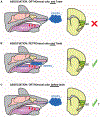Gustation and Olfaction: The Importance of Place and Time
- PMID: 30620909
- PMCID: PMC6996642
- DOI: 10.1016/j.cub.2018.11.038
Gustation and Olfaction: The Importance of Place and Time
Abstract
Animals can smell odors from the external environment or from their mouth via two routes: orthonasal and retronasal, respectively. Little is known about how the brain processes orthonasal and retronasal odors associated with taste, but a new study has revealed an important role for the gustatory cortex in such odor processing.
Copyright © 2018. Published by Elsevier Ltd.
Figures

Comment on
-
Retronasal Odor Perception Requires Taste Cortex, but Orthonasal Does Not.Curr Biol. 2019 Jan 7;29(1):62-69.e3. doi: 10.1016/j.cub.2018.11.011. Epub 2018 Dec 20. Curr Biol. 2019. PMID: 30581018 Free PMC article.
References
-
- Rozin P (1982). “Taste-smell confusions” and the duality of the olfactory sense. Percept. Psychophys 31, 397–401. - PubMed
-
- Hankins WG, Garcia J, and Rusiniak KW (1973). Dissociation of odor and taste in baitshyness. Behav. Biol 8, 407–419. - PubMed
-
- Palmerino CC, Rusiniak KW, and Garcia J (1980). Flavor-illness aversions: The peculiar roles of odor and taste in memory for poison. Science 208, 753–755. - PubMed
-
- Bouton ME, Jones DL, McPhillips SA, and Swartzentruber D (1986). Potentiation and overshadowing in odor-aversion learning: Role of method of odor presentation, the distal-proximal cue distinction, and the conditionability of odor. Learn. Motiv 17, 115–138.
Publication types
MeSH terms
Grants and funding
LinkOut - more resources
Full Text Sources

